Silver Wings 1/32 Sea Gladiator
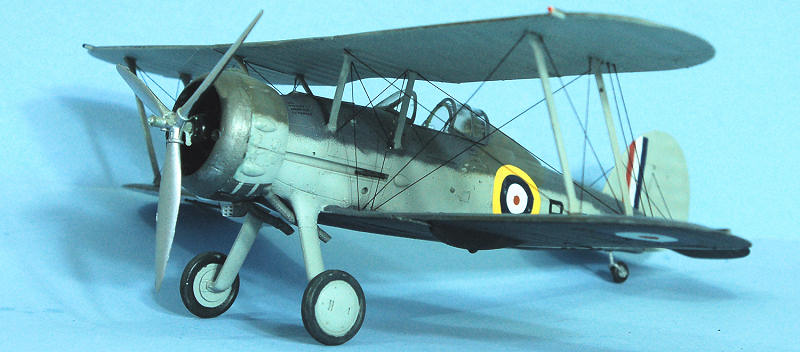
Once the Royal Navy lost control of their air arm with
the consolidation of the Royal Flying Corps and Royal Naval Air Service into the
Royal Air Force in April, 1918, the service that had pioneered the naval use of
aircraft and the ships to operate them was gradually outdistanced by both the
U.S. Navy and the Imperial Japanese Navy during the intervening years before the
outbreak of the Second World War. For instance, the Fairey Flycatcher of the
late 1920s‑early 1930s might have been wonderful to fly, but it was completely
outperformed by the Boeing F4B series of naval fighters in the
U.S.
and the Nakajima A4N. With flying officers not even serving in the Navy until
the service regained control of the Fleet Air Arm in 1938, there was virtually
no communication between the Royal Navy and the Royal Air Force; naval
requirements took a back seat to the needs of the Royal Air Force for its land
based squadrons, and the Navy had to make do with aircraft that were mostly
navalized versions of land based aircraft.
By
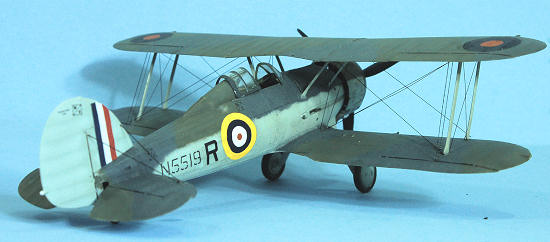 the
mid‑1930s, with the premiere British naval fighter being the Hawker Nimrod at a
time when the Japanese were using the A5M "Claude" and the
U.S.
Navy was operating the Grumman F3F series, British naval aviation was definitely
in the second rank.
the
mid‑1930s, with the premiere British naval fighter being the Hawker Nimrod at a
time when the Japanese were using the A5M "Claude" and the
U.S.
Navy was operating the Grumman F3F series, British naval aviation was definitely
in the second rank.
While there were designs in progress, with war clouds
gathering in late 1938 when the Nimrod was thoroughly obsolete, the Navy
urgently needed a new fighter with at least a chance of holding its own over the
ocean, where the likely opponent would not be operating single‑engine fighters.
The Admiralty was able to obtain sixty aircraft on the
RAF's Gladiator II contract (N5500‑N5549 and N5565‑N5574) on
May 24, 1939
as Sea Gladiators. Prior to this, 14 Gladiator IIs were fitted with arrester
hooks; others were used for familiarization training and were not intended for
operational use aboard carriers.
Both the
Watts
wooden two‑blade prop and the Fairey‑Reed metal prop were tested; while the
Watts
propeller was much superior for carrier operations, it was decided to
standardize on the Fairey‑Reed prop for the Sea Gladiators under construction.
In the end, the only difference between the Sea Gladiator and the Gladiator II
was the installation of an A‑frame arrestor hook below the rear fuselage ahead
of the tail wheel, and a dinghy carried in a container between the landing gear
legs.
The first Sea Gladiators went to 801 Squadron aboard HMS
"Courageous" at the end of May, 1939, with all the Sea Gladiators delivered by
the end of 1939 following the outbreak of war on September 3.
The Sea Gladiator first entered combat on April 22, 1940
during the German invasion of Norway, when Sea Gladiators of 804 Squadron aboard
HMS Glorious intercepted several
Heinkel bombers and shot down three while Gladiator IIs of 263 Squadron, RAF,
were being ferried to Lake Lesja.
By June 1940, when
Italy
entered the war, the Royal Navy and the Fleet Air Arm were stretched thin.
Fortunately, 18 Gladiators (serial numbers N5518 ‑
N5535) from 802 Squadron had been left at
Malta
in early 1940, by
HMS Glorious.
In March, although
Malta
was not facing attack, it was decided six Gladiators should be assembled, to
form an air defense unit that became known as the Hal Far Fighter Flight, which
eventually included both FAA and RAF personnel. Five Gladiators were eventually
assembled - N5525, N5527, N5530 and N5533 - but were then dismantled a few days
later.
In April, N5519, N5520, N5522 and N5531 were assembled
and test‑flown. In May, two more Gladiators - N5524 and N5529 - were assembled,
with the other crated aircraft to be used as spares.
The first Italian air raid came on June 11, 1940.
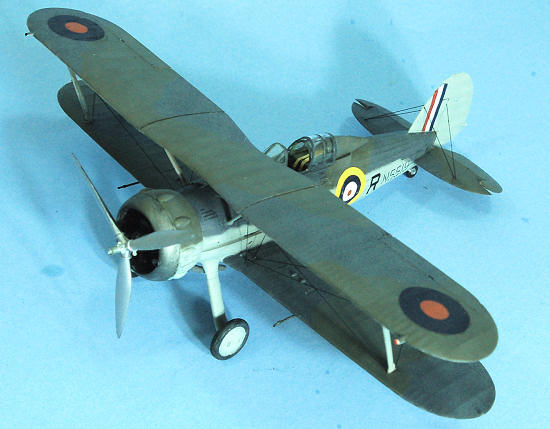 After suffering engine damage in combat, N5520 was
fitted with a Mercury engine and
Hamilton
propeller salvaged from a
Bristol
Blenheim bomber, which also used the Mercury engine. While top speed dropped
several miles per hour, climb and overall performance other than speed was
improved with the constant speed propeller.
N5519 was also fitted with a Blenheim engine and
propeller.
After suffering engine damage in combat, N5520 was
fitted with a Mercury engine and
Hamilton
propeller salvaged from a
Bristol
Blenheim bomber, which also used the Mercury engine. While top speed dropped
several miles per hour, climb and overall performance other than speed was
improved with the constant speed propeller.
N5519 was also fitted with a Blenheim engine and
propeller.
The myth about the Hal Far fighter Flight is that only
three aircraft, named “Faith,” “Hope,” and “Charity” constituted the entire
fighter cover of the island. In fact, the names “Faith,” “Hope” and “Charity”
were applied to the aircraft many months later by a Maltese newspaper, with the
story being propagated further as part of British wartime propaganda.
Four Hawker Hurricanes joined the Sea Gladiators at the
end of June and the Hal Far Flight became part of 261 Squadron RAF.
Only the Sea Gladiator later named “Faith” survived the
war, and can now be seen in the Malta War Museum in Valetta.
While the story of the Sea Gladiators of the Hal Far
flight at Malta have received much recognition for their role as the sole air
defense of the island during the opening stages of the air war aimed at reducing
it, there was another flight of Sea Gladiators operational in the Mediterranean
which also provided sterling service.
At the outbreak of war in the Mediterranean, HMS
Eagle ‑ the sole fleet carrier in the Med at the
time ‑ did not carry a fighter squadron.
Four Sea Gladiators ‑ N5512, N5513, N5517 and N5567 ‑
were hurriedly withdrawn from storage on Malta, assembled, and taken aboard the
carrier on June 16, 1940.
The Eagle Fighter Flight was commanded by CDR Charles
Keighly‑Peach, who managed to train several Fairey Swordfish pilots in fighter
tactics.
Almost one month later, on July 11, 1940, the British
Mediterranean Fleet was spotted by an Italian flying boat.
Though the Sea Gladiators intercepted and made contact,
their initial attacks were unsuccessful.
That afternoon, Keighly‑Peach ‑ known as K‑P to his men
‑ was on patrol over the fleet in N5517/6‑A, in company with Lt. Kenneth Keith
in N5513 when he spotted five S.79s below him, heading toward the ships.
The two Sea Gladiators dove vertically on the Italian
bombers, with K‑P heading for the lead plane as he closed to less than 50 yards
before opening fire. After three attacks, the Italian leader caught fire and
dropped back, before entering a spin and impacting the sea with no survivors.
K‑P was wounded in the thigh during the attack.
The two Sea Gladiators had to break off their attacks on
the other S.79s as the fleet opened fire.
On
July 14, K‑P was launched at dawn south of Crete.
At 0750, he spotted a lone S.79 and made three attacks
from out of the sun, with the result that this Sparviero
also caught fire and spun into the ocean.
Three hours later, in company again with Lt. Keith, the
two Sea Gladiators spotted three more S.79s approaching the fleet.
Keith opened fire on the left‑hand aircraft, joined by
K‑P, and the unfortunate Italian bomber crashed into the sea from their combined
fire. A few hours later, Keith was launched
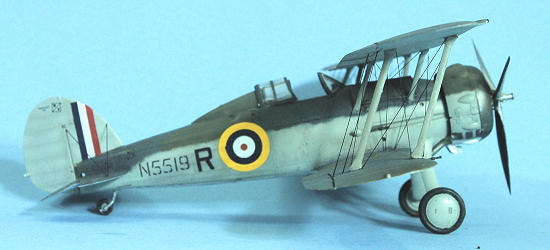 alone to
intercept a formation of S.81s from 200 Squadriglia;
after a beam attack and a stern chase, he sent one of these into the sea, to
mark the end of a very successful day for the flight. On July 29th, K‑P
intercepted another formation of S.79s and sent his third
Sparviero into the sea.
alone to
intercept a formation of S.81s from 200 Squadriglia;
after a beam attack and a stern chase, he sent one of these into the sea, to
mark the end of a very successful day for the flight. On July 29th, K‑P
intercepted another formation of S.79s and sent his third
Sparviero into the sea.
The next month, Eagle's Sea Gladiators were sent ashore
to Sidi Barani to provide fleet defense with RAF Gladiators when the fleet
bombarded the Libyan port of Bardia.
On August 17, separated from his flight over the British
fleet, Keighly‑Peach attacked two separate S.79s, forcing them to break off
their attacks though not shooting them down.
Lt. Keith bagged another S.79 in company with a
Gladiator from 112 Squadron RAF.
Overall, the Italians lost 4 bombers destroyed and
several damaged in this action.
Again off Crete on August 31, K‑P was launched with Lt.
Oliphant to intercept a shadower, which turned out to be a Cant Z.506B at 6,000
feet.
K‑P shot the floatplane down, with the crew escaping by parachute.
It was his last victory, making him the leading FAA
fighter pilot on the Sea Gladiator; he was awarded the DSO the following month
for his leadership of the Eagle Fighter Flight and his achievements over the
fleet.
Also in early September, HMS "Illustrious" arrived in
the Mediterranean with a full compliment of Fulmars in 806 Squadron, and
"Eagle's" foursome were no longer the only Fleet Air Arm fighters in the region;
they were then designated 813 Squadron.
On 6 November, 806 Squadron took aboard three Sea
Gladiators from 813 Squadron, as the carrier was tasked with covering two
convoys to Malta.
On November 8, 1940, Lt. Roger Nichols in N5549 and Sub.
Lt. Jack Sewell in N5513 destroyed a Cant Z.501, to record the last victory of
the Sea Gladiator at sea.
On January 10, 1941, following arrival of HMS
Illustrious at Malta with another convoy, the
three Sea Gladiators were off‑loaded and turned over to 261 Squadron on the
island, which was down to four effective fighters after heavy attacks.
On January 24, 1941, Sub. Lt. Sewell spotted a German
Ju‑88 diving toward Hal Far, and shot it down.
It was Sewell's fifth of an eventual 6 victories scored
with Sea Gladiators and Fulmars, and also the last victory by a Sea Gladiator
over Malta.
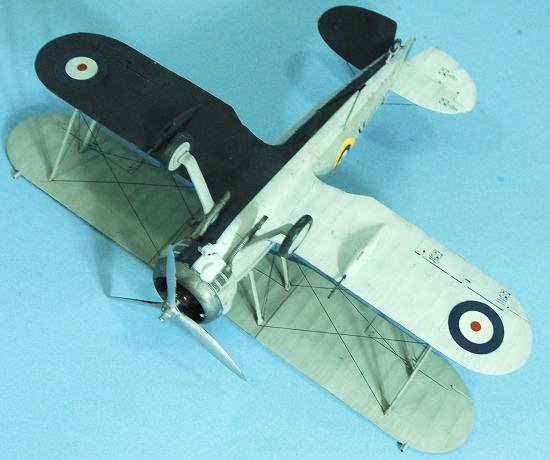 The Gloster Gladiator has been a popular kit since at
least the early 1960s, when Airfix released a kit in 1/72.
In the 1970s, both Matchbox and Heller released
Gladiators; all of these were RAF Gladiator Is.
Sword recently released a Sea Gladiator in this scale,
the first time the Sea Gladiator has been released as a kit.
This kit by Silver Wings in the first 1/32 Gladiator of
any kind, and presages releases later this year of the Gladiator I and Gladiator
II.
The Gloster Gladiator has been a popular kit since at
least the early 1960s, when Airfix released a kit in 1/72.
In the 1970s, both Matchbox and Heller released
Gladiators; all of these were RAF Gladiator Is.
Sword recently released a Sea Gladiator in this scale,
the first time the Sea Gladiator has been released as a kit.
This kit by Silver Wings in the first 1/32 Gladiator of
any kind, and presages releases later this year of the Gladiator I and Gladiator
II.
The kit is as superb as all the previous Silver Wings
1/32 kits, with surface detail that is sharper than many injection-molded kits,
a fully-complete cockpit and a very accurate Mercury engine.
All control surfaces are cast separately.
The cabane and interplane struts, and the landing gear,
are cast with wire cores, providing adequate strength for these important parts.
A Fairey-Reed propeller and a Hamilton-Standard
propeller are provided.
The three piece canopy is in clear cast resin.
A dingy pack and A-frame arrestor hook are included. A
photoetch fret includes the seat belts and the fuselage radiator.
Decals are provided for three Sea Gladiators:
3 marking options: Sea Gladiator N5519 "R", Gladiator
Flight Hal Far, Malta, June 1940; Sea Gladiator Mk II N 5519"G6A", 802 Squadron,
HMS Glorious, 1939; Sea Gladiator N5524, No 261 Squadron, Luqa, Malta, January
1941.
Construction begins with the cockpit.
The kit is designed for an experienced modeler, and
while all the parts fit perfectly, it is important to study the drawings and be
sure you are orienting the parts correctly. I managed to reverse the floor,
which I did not realize had happened until the assembly had gotten to the point
where it was not possible to cut things apart and start over without serious
threat of breakage of the very fragile interior.
Thus, I did not lower the cockpit flaps to more fully
display the cockpit interior.
It is important to test fit everything.
I found that I needed to do more than a bit of sanding
to the shape of the instrument panel to get it to fit inside the fuselage.
Since this involved fitting three separate photoetch
parts, it did create problems but eventually everything fit correctly.
Of course, it was after all this was glued into position
in the f fuselage that the problem of the reversed floor became apparent.
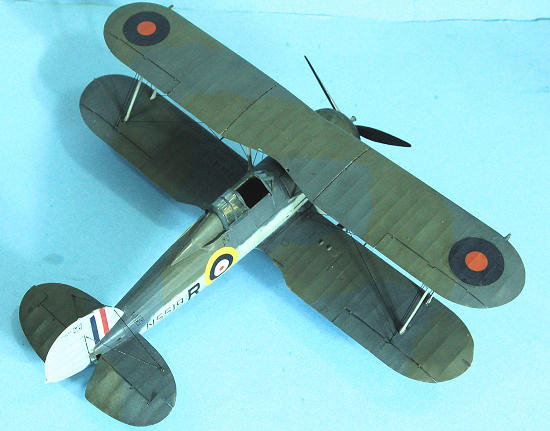 The other area of difficulty is the assembly of the
cowling, which comes in four parts: the exhaust collector ring and the three
separate panels.
Getting these parts fitted correctly around the engine took
several tries.
I then realized that the collector ring was not a uniform shape,
which was a mistake in casting that can frequently occur with resin parts.
I ended up applying a considerable amount of Squadron
green putty to the cowling and then eyeballing the shape as I modified it with a
sanding stick.
The other area of difficulty is the assembly of the
cowling, which comes in four parts: the exhaust collector ring and the three
separate panels.
Getting these parts fitted correctly around the engine took
several tries.
I then realized that the collector ring was not a uniform shape,
which was a mistake in casting that can frequently occur with resin parts.
I ended up applying a considerable amount of Squadron
green putty to the cowling and then eyeballing the shape as I modified it with a
sanding stick.
The rest of the assembly is easy. The mounting pegs for
the wings insure proper dihedral for both upper and lower wings.
You will have to drill out the locating holes for the
cabane and interplane struts.
The very nice two-part tailwheel leg and wheel is a
notably weak assembly, since it is scale thickness and done in resin.
This part would have been better done in white metal, so
you are advised to handle with care once the model has been built, because it
will be easy to break, and it may deform over time since the kit is relatively
heavy.
Once I had assembled the kit other than to attach the
upper wing - which I test-fitted to insure proper fit - the model was ready for
the paint shop.
The Fairey-Reed propeller is not well-designed, being
overall too thin, and not cast with an airfoil cross section.
When I tried to sand it to shape, I managed to break it.
I was glad to discover in the Squadron “Sea Gladiator in
Action” that N5519 had been re-equipped with a Blenheim engine and prop, so I
used the very nice Hamilton prop.
If you are building a Malta Sea Gladiator, you should
leave off the A-frame arrestor hook, which these aircraft did not use.
Painting:
I first painted the black/white lower wing, fuselage and
tail, then masked these off.
I used Gunze-Sangyo “Aircraft Grey” for the lower
camouflage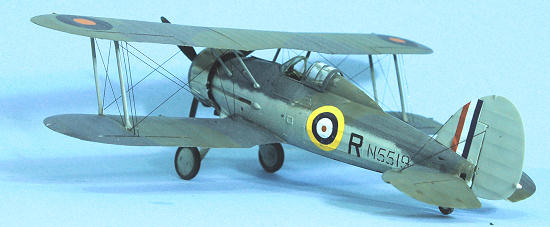 color, and Xtracrylix “Extra-Dark Sea Grey” and “Dark Slate Grey” for the upper
camouflage colors, which I post-shaded with a bit of white in each color for
second coats.
When all was dry, I have the model an overall coat of Future.
color, and Xtracrylix “Extra-Dark Sea Grey” and “Dark Slate Grey” for the upper
camouflage colors, which I post-shaded with a bit of white in each color for
second coats.
When all was dry, I have the model an overall coat of Future.
Decals:
The upper Type B roundel as provided in the kit decals
is not the right dimension, being closer to the modern RAF “B” roundel with the
larger red center.
I replaced this with a set of roundels from the decal
dungeon, as well as replacing the fuselage roundels since one had been slightly
misprinted and was out of register just enough to be noticeable.
I used the kit decals for everything else, and also used
some stencils from a Hurricane sheet for the W/T markings.
I attached the upper wing and then gave the model an
overall coat of Xtracrylix Clear Flat varnish.
The rigging was done with .010 wire.
Outside of “modeler mistakes,” the kit makes up into
a very nice, accurate model of the Sea Gladiator.
The major area of concern during assembly is to get
the engine inside the cowling and the cowling together correctly.
Past that, this is the best kit of a Sea Gladiator
in any scale, and is definitely worth the price for anyone who is a fan of
the Gladiator.
I look forward to the next releases.
Recommended for modelers with experience in building
full-resin limited-run kits.
Tom
Cleaver
February 2011
Review Kit couresy of
Coopers Models.
Get yours today.
If you would like your product reviewed fairly and quickly, please
contact
me or see other details in the
Note to
Contributors.
Back to the Main Page
Back to the Reviews Index Page


 the
mid‑1930s, with the premiere British naval fighter being the Hawker Nimrod at a
time when the Japanese were using the A5M "Claude" and the
the
mid‑1930s, with the premiere British naval fighter being the Hawker Nimrod at a
time when the Japanese were using the A5M "Claude" and the  After suffering engine damage in combat, N5520 was
fitted with a Mercury engine and
After suffering engine damage in combat, N5520 was
fitted with a Mercury engine and  alone to
intercept a formation of S.81s from 200 Squadriglia;
after a beam attack and a stern chase, he sent one of these into the sea, to
mark the end of a very successful day for the flight. On July 29th, K‑P
intercepted another formation of S.79s and sent his third
Sparviero into the sea.
alone to
intercept a formation of S.81s from 200 Squadriglia;
after a beam attack and a stern chase, he sent one of these into the sea, to
mark the end of a very successful day for the flight. On July 29th, K‑P
intercepted another formation of S.79s and sent his third
Sparviero into the sea. The Gloster Gladiator has been a popular kit since at
least the early 1960s, when Airfix released a kit in 1/72.
In the 1970s, both Matchbox and Heller released
Gladiators; all of these were RAF Gladiator Is.
Sword recently released a Sea Gladiator in this scale,
the first time the Sea Gladiator has been released as a kit.
This kit by Silver Wings in the first 1/32 Gladiator of
any kind, and presages releases later this year of the Gladiator I and Gladiator
II.
The Gloster Gladiator has been a popular kit since at
least the early 1960s, when Airfix released a kit in 1/72.
In the 1970s, both Matchbox and Heller released
Gladiators; all of these were RAF Gladiator Is.
Sword recently released a Sea Gladiator in this scale,
the first time the Sea Gladiator has been released as a kit.
This kit by Silver Wings in the first 1/32 Gladiator of
any kind, and presages releases later this year of the Gladiator I and Gladiator
II.  The other area of difficulty is the assembly of the
cowling, which comes in four parts: the exhaust collector ring and the three
separate panels.
Getting these parts fitted correctly around the engine took
several tries.
I then realized that the collector ring was not a uniform shape,
which was a mistake in casting that can frequently occur with resin parts.
I ended up applying a considerable amount of Squadron
green putty to the cowling and then eyeballing the shape as I modified it with a
sanding stick.
The other area of difficulty is the assembly of the
cowling, which comes in four parts: the exhaust collector ring and the three
separate panels.
Getting these parts fitted correctly around the engine took
several tries.
I then realized that the collector ring was not a uniform shape,
which was a mistake in casting that can frequently occur with resin parts.
I ended up applying a considerable amount of Squadron
green putty to the cowling and then eyeballing the shape as I modified it with a
sanding stick.